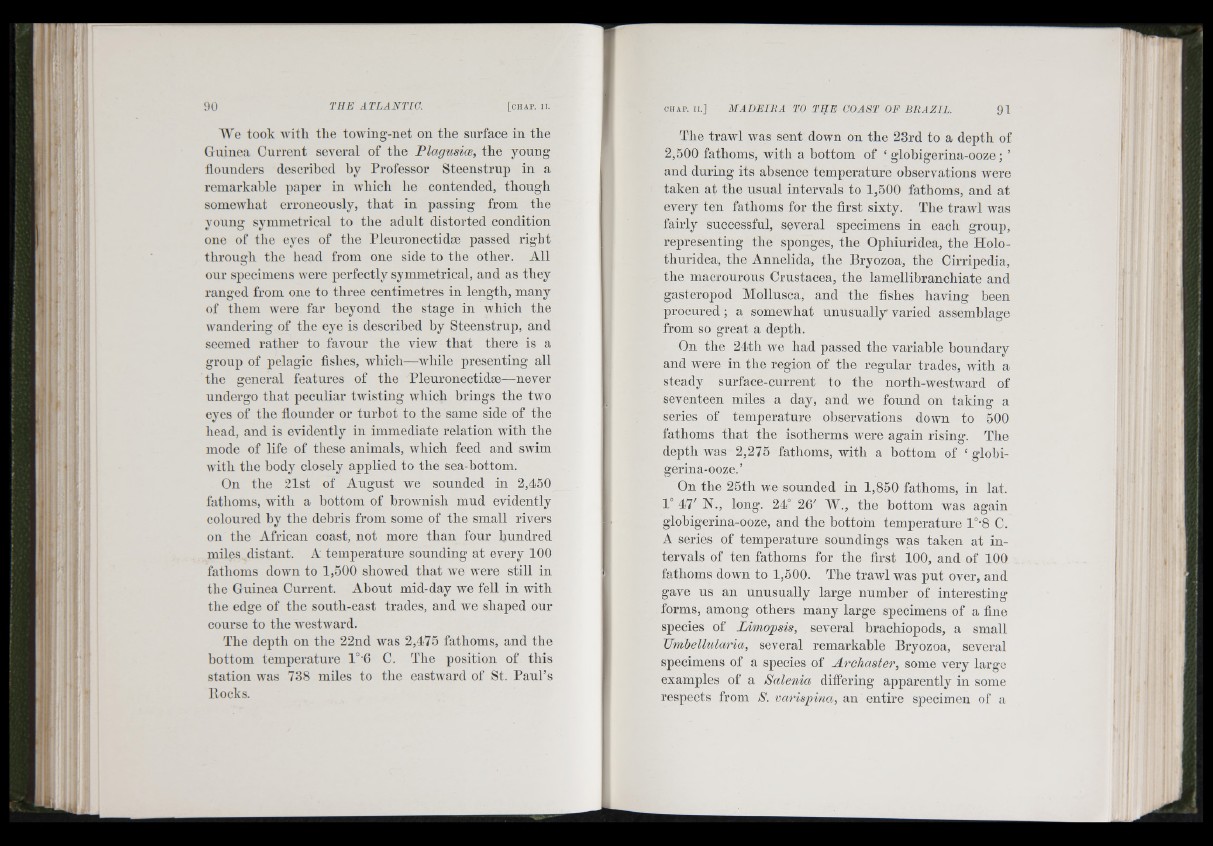
We took Avitli the towing-net on the surface in the
Guinea Current several of the Flagus'm, the young
flounders described hy Professor Steenstrup in a
remarkable paper in Avhich he contended, though
somewhat erroneously, that in passing from the
vouno; svmmetrical to the adult distorted condition
one of the eyes of the Pleuronectidae passed right
tlirouMi the head from one side O to the other. All
onr specimens were perfectly symmetrical, and as they
ranged from one to three centimetres in length, many
of them were far beyond the stage in Avhich the
wandering of the eye is described by Steenstrup, and
seemed rather to favour the Anew that there is a
group of pelagic fishes, which—Avhile presenting all
the Oo-eneral features of the Pleuronectidse—never
undergo that peculiar twisting which brings the tAvo
eyes of the flounder or turbot to the same side of the
head, and is evidently in immediate relation with the
mode of life of these animals, Avhich feed and swim
Avith tbe body closely applied to the sea-bottom.
On the 21st of August Ave sounded in 2,450
fathoms, Avitli a bottom of brownish mud evidently
coloured hy the debris from some of the small rivers
on the African coast, not more than four hundred
miles distant. A temperature sounding at every 100
fathoms down to 1,500 showed that Ave were still in
the Guinea Current. About mid-day we fell in with
the edge of the south-east trades, and Ave shaped onr
course to the Avestward.
The depth on the 22nd Avas 2,475 fathoms, and the
bottom temperature 1°'6 C. The position of this
station Avas 738 miles to the eastAvard of St. Paul’s
Pocks.
The traAvl Avas sent down on the 23rd to a depth of
2,500 fathoms, with a bottom of ‘ globigerina-ooze ; ’
and during its absence temperature observations Avere
taken at the usual intervals to 1,500 fathoms, and at
every ten fathoms for the first sixty. The traAvl Avas
fairly successful, several specimens in each gronj),
representing the sponges, the Ophiuridea, the Holo-
thuridea, the Annelida, the Bryozoa, the Cirripedia,
the macrourous Crustacea, the lamellibranchiate and
gasteropod Mollusca, and the fishes having been
procured ; a somcAvhat unusually varied assemblage
from so great a depth.
On the 24th we had passed the variable boundary
and Avere in the region of the regular trades, Avith a
steady surface-current to the north-westAvard of
seventeen miles a day, and we found on taking a
series of temperature observations down to 500
fathoms th a t the isotherms Avere again rising. The
depth was 2,275 fathoms, with a bottom of ‘ globigerina
ooze.’
On the 25th we sounded in 1,850 fathoms, in lat.
1° 47' N., long. 24° 26' W., the bottom was again
globigerina-ooze, and the bottom temperature l°-8 C.
A series of temperature soundings was taken at intervals
of ten fathoms for the first 100, and of 100
fathoms down to 1,500. The traAvl Avas put over, and
gave us an unusually large number of interesting
forms, among others many large specimens of a fine
species of Limopsis, several brachiopods, a small
JJmbellularia, several remarkable Bryozoa, several
specimens of a species of Archaster, some AYry large
examples of a Salenia diifering apparently in some
respects from S. oarispina, an entire specimen of a